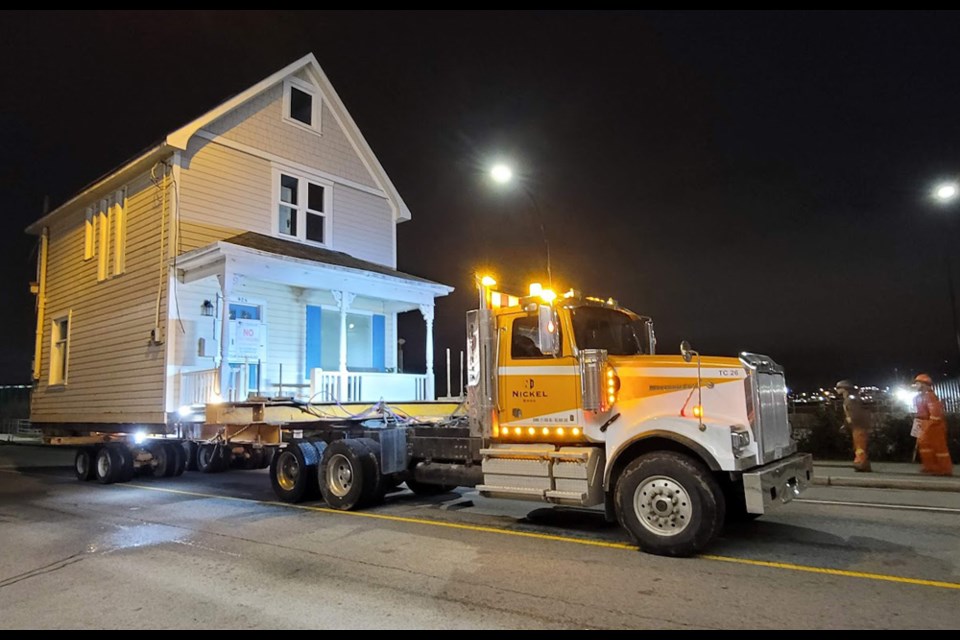Think of it as retiring to quieter island community when you reach a certain age and city living is no longer for you – except it’s the house that we’re talking about.
Late Saturday night, contractors gingerly loaded up two North Vancouver heritage homes and moved them to barges to ferry them to their new permanent locations on Lopez Island in the San Juans and Bowen Island.
The Cook and Schiplo residences from 424 and 428 East Third St. were built in 1927 and 1908, respectively. But in 2020, Cascadia Green Developments purchased the lots with plans to redevelop them into a mixed-use commercial/residential project.
When North Shore Heritage vice-president Jennifer Clay saw the lots up for redevelopment, she and the group’s members went to work lobbying City of North Vancouver council and Cascadia to find a way to incorporate the homes into their plans. When that didn’t work, they alerted Nickel Bros, the go-to contractor for prepping a salvageable house to be moved, finding a buyer and handling the daunting logistics of getting it there.
Cascadia agreed to let the homes go free of charge.
“At Cascadia Green Developments, we are committed to providing accessible homes, from our rent-to-own plan, live work studios and relocating houses whenever possible. Moving these three homes is an ideal fit for our company’s vision,” said Cascadia founder Farzad Mazarei,” in a press release.
To facilitate the move, the city had to temporarily close down Third Street, St. Patricks Avenue and East Esplanade, allowing the Nickel Bros. crew to slowly pull the houses down to Seaspan’s dock, while support crews removed hydro and telephone wires to give the oversized loads safe clearance.
By early morning, they’d reached the barges and left the inlet. (A much newer 2014 duplex from between the two was also carted away.)
It was exciting to see the process play out, but heritage advocates always have mixed feelings when an old-timer leaves town. They prefer to see them stay in place and, when that’s not possible, have them moved elsewhere in the same community, Clay said.
“It's kind of a win, right? At least they're safe. They're not going to be staying in North Vancouver but they're also not going to landfill,” she said, adding that to rebuild the same houses today would require the lumber of about 200 trees. “The greenest building is the house that’s already built.”
In the city’s heritage register, the Cook Residence is described as a modest bungalow demonstrating the late persistence of the Craftsman style, which was the predominant style of home before the First World War. Heritage features include “a jerkin-headed front-gable roof, twin-coursed shingle cladding, decorative triangular eave brackets and triple assembly windows with decorative muntins in the upper sash.”
With its tall and narrow proportions, the Schiplo Residence was done more in the Victorian style. It was built on spec by a carpenter with an eye for ornamentation, including lathe-turned veranda columns with intricate scroll-cut brackets.
“They’re getting extremely well constructed houses, made of first-growth wood. Not the same kind of shortcuts that a modern builder would probably take. Rock solid materials,” Clay said. “There's no reason why it wouldn't last another 100 years.”
Apart from their distinct style and craftsmanship, there’s something else that draws people to heritage homes, Clay said. The new owner of the Cook residence has been eager to know more about its heritage value and the history of its previous inhabitants. Both the Cook and Schiplo homes were lived in by the families of labourers who worked in the shipyards on the North Vancouver waterfront.
“The house has been lived in and loved by many families before. And yes, it's intangible, but the history is there,” Clay said.
Clay said she would like to see developers be more proactive with finding new owners for heritage homes before they’re demolished and helping to pay to cover the cost of moving them, as relocation tends to be cheaper than demolition, she said.
Check out this time-lapse video of one of three houses trucked down St. Patricks Avenue to Seaspan’s dock for barging to its new home.




